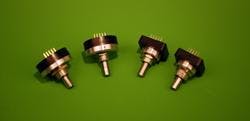New Rotary Magnetic Encoders Offer Improved Performance Over Traditional Optical Encoders and Potentiometers
The new ED Series of magnetic encoders by Measurement Specialties provide a platform for traditional optical encoder and potentiometer replacement with several significant improvements over existing electro-mechanical designs. The advantages inherent in magneto-resistive (MR) technology enable more robust sensor system designs offering lower total cost. MR technology offers non-contacting sensing, which allows the electronics to be shielded from the operating environment. The ED product family utilizes encapsulated (potted) electronics, virtually eliminating contamination in even severe conditions. Component life is greatly extended with the loss of traditional mechanical contacts or LED degradation present in optical devices. Performance in environmental extremes is also improved with extended temperature range and humidity capabilities. The ED-18, ED-19, ED-20 and ED-21 Series products are offered in several industry competitive packages. These products feature resolutions from 64 to 1024 counts per rotation (CPR) and integrated line driver options with active termination for longer cable runs. Analog versions are also available with outputs from 0 to 5 Vdc, 0.5- 4.5 Vdc, 0 to 20 mA or 4-20 mA which can be used as industrial potentiometer replacements or as human machine interface (HMI) devices. Applications for the new ED Series encoders including positional feedback, control knobs, motor control, servo valve positioning, steering and throttle control, pump speed and direction, camera positioning, medical and test equipment and more. These sensors are especially sell suited to equipment used outside. Customization is offered for OEM applications (<1000 units/annum), including modifications to CPR, output signal and more. The modularity designed into the ED Series platforms also allows for custom mechanical packaging, additional electronic capabilities, or even full integration into custom OEM assemblies as shown in the attached photograph. A significant design advantage to this packaging concept is the de-coupling of the magnet (rotating) side of the sensor from the electronics package – the two do not have to be physically attached – which enables the sensor portion to be protected behind a non-ferrous barrier. This feature allows for much greater flexibility when integrating the technology into OEM applications. About Measurement SpecialtiesMeasurement Specialties, Inc. (MEAS) designs and manufactures sensors and sensor-based systems to measure precise ranges of physical characteristics such as pressure, temperature, position, force, vibration, humidity and photo optics. MEAS uses multiple advanced technologies – including piezoresistive, electro-optic, electro-magnetic, capacitive, application specific integrated circuits (ASICs), micro-electromechanical systems (MEMS), piezoelectric polymers and strain gauges – to engineer sensors that operate precisely and cost effectively. • Standard Resolution 256, 128 and 64 counts per revolution (CPR) 4 counts=1 pulse • Operating Temperature –40°C to +85°C (Extended temperature • range available, contact factory for details) • Maximum Speed 300 RPM • Bearing Life 3,000,000 cycles • Bearings Sleeve • Run Out .010” max @ .75” from mounting surface • Bushing Mounting Torque 10 in-lb max • ELECTRICAL • Maximum Current Draw 15 mA • Operating Voltage (VDC) 5 +/- 0.25 VDC • Output Type Open Collector with internal 10 k? pullup • Voltage Output High (Voh) Minimum 4.75 Vdc • Voltage Output Low (Vol) Maximum 125mV @ 16 mA • Duty Cycle 50% +/- 25% • Phase Angle 90° +/-45° (Ch. A leads Ch. B Clockwise) • Note: All specifications are specified with Vdd @ 5.00 Vdc and Ambient Temperature Ta @ 25 Degrees Celsius. • MECHANICAL • Axial Load (lbs) 4.5 [20 N] Max. • Radial Load (lbs) 2.25 [10 N] Max. • Operating Speed (rpm) 300 = Sleeve • Shaft End Play (in) .005 [.10] Max. • Shaft Radial Play (in) .010 [.25] Max. @ .6 [15.2] from mounting surface • Shaft Push-in Force (lbs) 40 [9N] • Shaft Pull-out Force (lbs) 6 [1.3N]
